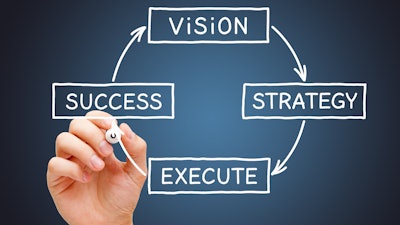
In the early days of civilization, work’s purpose was to conquer nature and provide the fundamental elements of food, clothing and shelter. As humans evolved, so did work.
The rise of the guild system to the Industrial Revolution and now, the Digital Age, has paved the way for ongoing shifts in how we live, work and play.
Today, we are in the midst of the Force for Good era — a time where people come first and leaders must provide purpose and impact, as well as the opportunity to fulfill potential.
Distributors are perfectly positioned to seize this opportunity and grow their people, business and impact. How do I know this? Because I’ve been privileged to hear tales of successful transformation and the triumph of human spirit from:
- Individuals who confessed that the ethos of their workplace not only shaped them into better professionals but also better human beings, lessons now trickling down to the next generation.
- Companies giving the misunderstood, the felons, a second shot at redemption and then beaming with pride, watching them reclaim their rightful place in society.
- Companies operating on the “Golden Rule,” where every employee feels valued and treasured.
- Workplaces moving away from the cold, “up or out” mentality and instead embracing the belief that every person has a unique role to play and a distinct song to sing.
Data supports this. In our Future of Distribution research, 95% of distributors surveyed say leaders must have the mindset and ability to not just help our employees perform their job, but also thrive personally and professionally.
Distribution leaders must transform their business models and cultures to remain competitive. Superficial slogans are no longer enough. Successful transformation requires a move beyond the concept of transformation as a mere platitude to one that involves a strategic plan built with a framework in mind.
“It’s Just Too Hard.”
It’s a phrase I hear time and again, and I understand why. Transforming an existing business is like rebuilding an airplane in flight.
The cost and complexity of transformation can make the task feel too complex to bear. We see this overwhelm play out over and over as we witness acquisitions of those not ready or prepared to embrace today’s realities, leading some to sell or exit the market altogether.
“Just too hard” — that’s thinking in a transactional way, which was fine when the world allowed for it. But, by all accounts, those outdated mindsets need to shift and be reimagined to embrace the future.
Technology. Artificial intelligence. Efficiency. None of it matters if we don’t focus on our people.
Transformation can no longer be a platitude. Over the years, technological advancements, shifting market dynamics and evolving customer expectations have continuously reshaped the landscape, requiring leadership to change or be left behind.
Mindset and Ambition: The Keys to Successful Transformation
I’m reminded of a recent stop on the We Supply America tour when I visited Bradford White, an employee-owned American manufacturer of water-heating, boilers and storage products committed to professional installation. I asked retiree Jeff Helmus to sum up his 30 years of experience there. You know what he said? “The American Dream.”
He spoke about his progression with the company — starting as a senior in high school alongside his father in the truck garage. From washing and fueling trucks, to jobs on the line, and then repair and painting work — eventually retiring as the manufacturing manager.
From day one, he was just looking for an opportunity to grow into the best version of himself.
“I always wanted to learn more and make our company better. I didn’t always make the right decisions, and we were always held accountable, but never in a way that was discouraging. We learned from our mistakes, and we improved because of those mistakes. BWC had that culture, and we managed with a commitment to it,” he wrote me in a follow-up message after my visit.
What a North Star
To think that an organization can give someone the opportunity to live the American Dream.
“Over the years I was asked several times what kept me working at the same place and never wanting to try something else. I always said, ‘I’m part of a family here, they take care of us; where else would I want to go?’”
Helmus’ story and countless others like it do not happen by chance. It’s the result of an organization putting its mindset and ambition into a plan.
But what is a business’ ambition? It’s not an easy thing to measure. Is it to achieve profit? Or is it to create collaborative, purpose-driven and aligned teams who have each other’s backs?
I’m reminded of electrical distributor Schaedler Yesco, another stop on the We Supply America tour. They were recently named a Top Growing Company in Pennsylvania for the 10th time in a row.
The special sauce?
They believe that to grow the business, they have more work to do. Yet, they don’t want to suck the soul out of their employees.
In fact, visit Schaedler Yesco, and you’ll see their philosophy upfront and center on signs that read:
“Work hard. Go home happy.”
It’s not a program, it’s not an initiative. It’s who they are and what they believe in. It’s how leadership wants to live and that filters down to who they employ. They are appreciative of the work their people do, not only for the company but for the greater good.
How Can Distributors Go Beyond Platitudes and Put This Into Action?
APR Supply Co. has its sights set high. Its goal is to double sales every five years, and the company’s track record speaks for itself. They generate profits far above industry average. Want to know what they do with some of that profit? They take 50% of it and share it with employees equally. Equally, which means the janitor gets the same as Scott Weaver, president and CEO. What holds a company back from taking leaps of faith like this?
Chris Blaylock, audit partner at Wipfli, our partner in the We Supply America tour, says it’s the risk of failure. “There’s definitely a bottom-line approach to some of these decisions and a lack of trust.”
But Blaylock says the We Supply America tour highlights companies that found a way to make a profit while engaging employees. The result is greater success because employees feel included, and know it will pay dividends for them, as well. “The leaders in those organizations have been able to communicate that vision and create excitement around it for each of the employees to jump on board.”
While Blaylock stressed that transformation takes time and is built by “walking the walk,” he also doubled down on the value of HR in long-term organizational transformation. “If the entire leadership group is in lockstep and can demonstrate that excitement behind what the vision is, the HR leader has to be a part of that. They’re going to understand the person and have more detail into what drives an individual because of their function. It’s an entire leadership team, and HR should be part of that leadership team to drive that vision and communicate that vision.”
Will Quinn, director of industry and solution strategy at Infor, another We Supply America supporter, says the first step to strategically transform your business is to not overlook the planning stage.
“Typically, go-getters like to skip the planning phase and jump right in. It doesn’t usually end well. You have to start with the end goal in mind. What are your goals and aspirations? Then, think what do I need to achieve that? Once you have that, your activities should point to reaching those goals. Without a clear plan and routine sanity checks, you can wind up going in too many directions.”
Embrace a New Leadership Paradigm
The days of leadership rooted solely in numbers, charts and cold transactions are dwindling. The new leadership paradigm heralds leaders who not only oversee tasks but inspire change, growth and lasting impact.
Leaders like those at APR Supply, Schaedler Yesco and Bradford White don’t just get things done but transform the very essence of their organizations. They are intentional about re-engineering their businesses.
Yes, it’s hard. But it’s also possible. And it’s happening every day at distribution businesses throughout this country. Because they know that the transformation they need is possible. And if they don’t embrace it, they’ll lose their opportunity to be a Force for Good.
Dirk Beveridge is the founder of UnleashWD, executive producer at We Supply America, president of the Beveridge Consulting Group, and champion for the "noble calling of distribution" for over 37 years.























